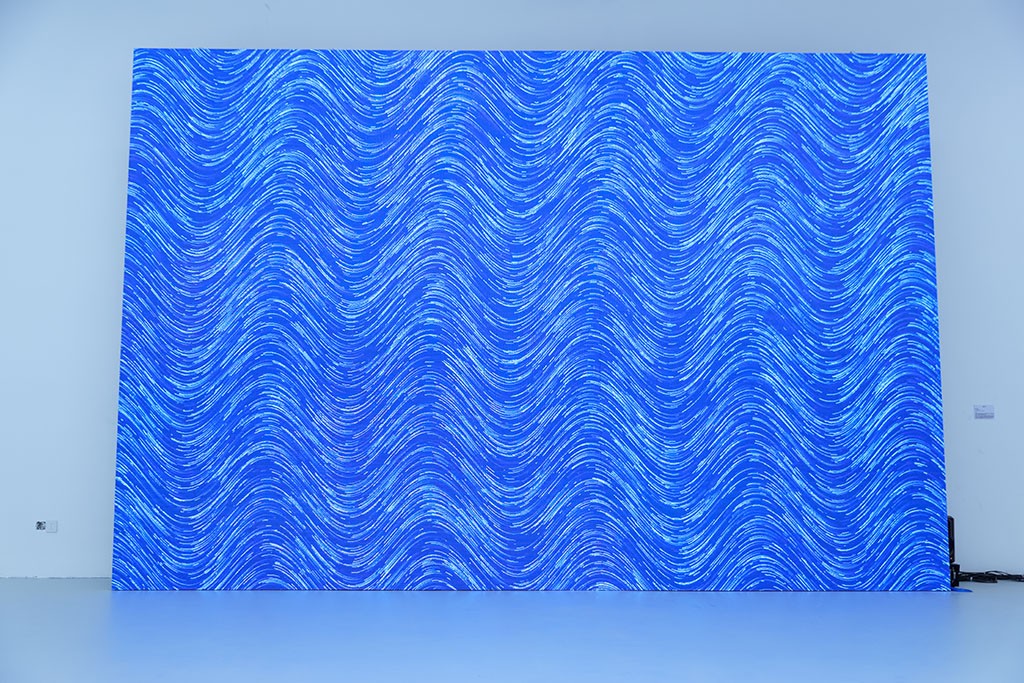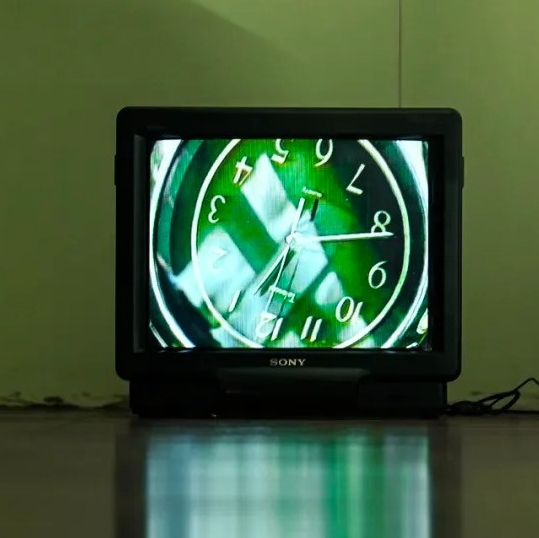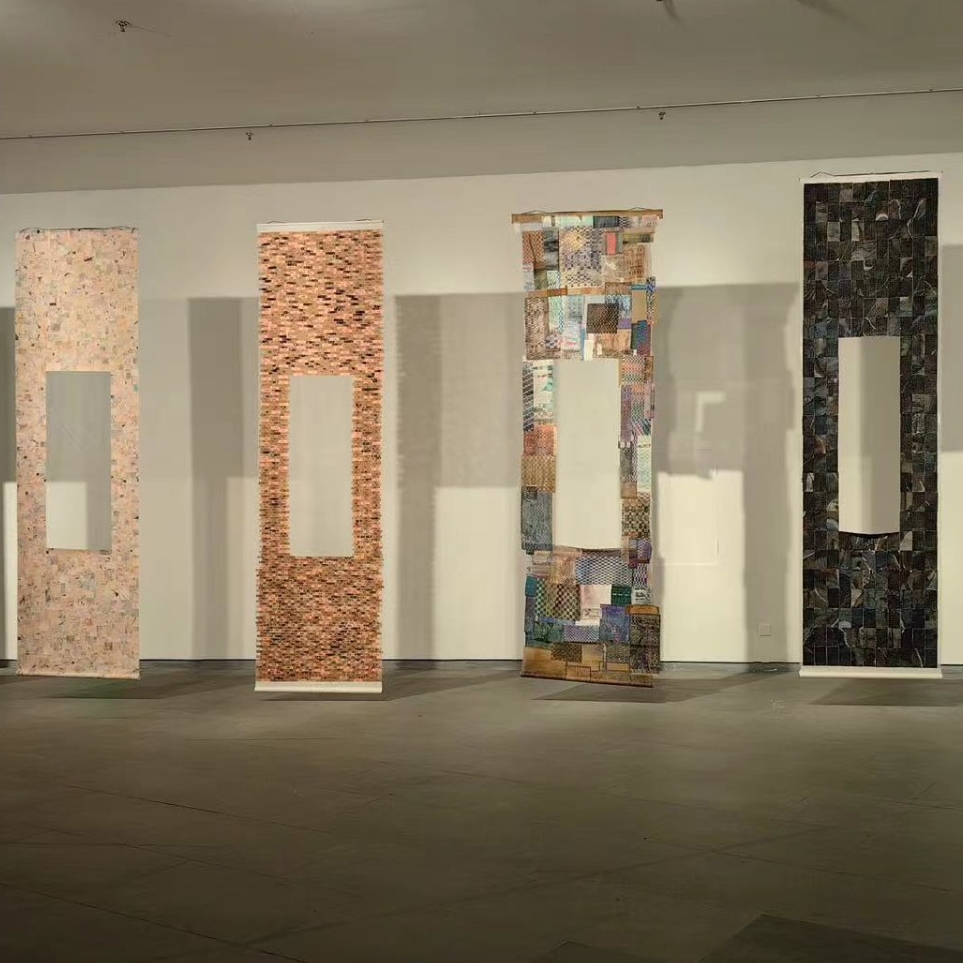
Detail of APEX, Courtesy of Tianchan Chen
APEX, made by Tianchan Chen in 2023, is an audiovisual work I cannot, and do not, hope to be able to adequately put into words. Visually, the work is composed of uniform-width moving lines and the occasional blinking dot atop a color-changing background which rests at an ocean blue. The lines often change color throughout the work but are predominantly white, appearing as seraphic and of a utopian technological future. These lines vary in their movements, starting out as vertical sine waves, then switching to straight lines at times, circular at others, and many more abstract shapes in between. The transition of one movement form to another is usually demarcated by dissolve cuts of varying speed, often a quick dissolve but broken up with slow dissolves, freeze frame dissolves, a flash cut, a fade-to-black, and a few blunt cuts to finish the work. Between these transitions, the lines will change their course of movement in front of the viewer, as well as change color. The lines move around or are pulled by invisible voids of a circular organic shape, beginning in the center of the work but multiplying and appearing throughout the frame later on. The “camera” (this is a generated work, seemingly made using AI, so the camera is not a material object of capturing but rather a digitally positioned one) moves twice throughout the work early on: a zoom out of a wormhole to show us a circular shape of lines, and a slide upwards and left away from this circular image.
 Tianchan Chen as the Curator, introduced the exhibition.
Tianchan Chen as the Curator, introduced the exhibition.
The sound of the work blurs the line between generative and found footage work; the sounds feel found and sampled from various sources, but these sources are usually unidentifiable to the viewer. We are first met with a heavenly harmony of chords with a large range of notes, high low and middle frequencies all present with an emphasis on the middle. These chords stay present through the entire work, wavering but never drastically changing, and are most likely what made call the lines seraphic. While these chords play, different sounds flow in and out of the work, occasionally functioning as sound effects for the visuals, but usually interacting with the visual portion in a less literal way. There are some sounds we can concretely identify, such as three tranquil piano melodies briefly played, but most of the sounds are invocations of things rather than the sound of an identifiable object. The sounds span different temporalities, feeling either ancient, futuristic, or of the near past, invoking ideas of nature, robotics, and the human. We hear an animalistic clicking, what sounds like a whale call mixed with a flute, and multiple bird-like noises; piano tunes, seemingly a drum circle, and possibly and industrial era train; laser noises, and oscillating electronic hum, and the sound of bending metal on a large scale as if it was out of a Transformers movie. While the robotic and natural sounds are more frequent than those explicitly human, there is no chronological ordering to these sounds. Many of them repeat, and they will be seamlessly integrated with one another at the same time. Some sounds will even evoke both the natural and the futuristic; we hear sounds of the deep sea mixed with a computer rumbling as we look at something resembling a whirlpool.
The work completely washes over you as you watch it in a dark room with surround sound and on a large projector. It creates a narrative of grandeur, a narrative of integration between an organic nature that has been here long before humans, and future technologies which will coexist with this nature long after humans. We are exposed to a teleological narrative of the Earth and universe which we can feel deeply but cannot comprehend or grasp in a concrete fashion, and we are not the focal point of this narrative. We are the blinking dots briefly present among the lines traveling throughout the surface of APEX. It works in its favor that APEX is seemingly an AI-generated work. As in many AI-generated artworks, the movement present in the work is very difficult for the human eye to track; we can see the movement happening, but the way in which objects move is foreign to our logic. This often occurs to an ugly effect, but this is not the case for this work. It does not reappropriate and butcher that which is human, but works in the abstract and organic, vaguely invoking motifs we see in nature like the golden spiral and moving out of this into geometric line work, making me think of the romanticism imbued within math and geometry, finding the objective ratios of objects within the world, revealing the platonic logic of the world we inhabit. It does not feel like Tianchan gave orders to an AI program and had it attempt to create what he envisioned. Rather, it feels as if he has figured out how to communicate with AI and has convinced it to reveal to us the teleological narrative and non-human forms of the universe on its own terms. This gives credence to the grand aspirations of this work and is part of what makes the work sucessful. If Tianchan himself, or any other person for that matter, tried to tell me the telos of the universe and our place within it, I could think it was cool, but would not treat it as credible information I was receiving. Instead, with Tianchan sharing the information which he has not figured out but has instead created by collaborating with a non-human entity, there is a newfound legitimacy in this radical narrative and incomprehensible meaning of the universe presented to us. As the viewer, we learn to accept that this meaning and narrative of the universe is not something that is comprehensible via human logic and are grateful to experience it as such rather than trying to turn it into a linguistic formula we can refer back to.

Installation View of APEX, Courtesy of Tianchan Chen
While this incomprehensible telos presented to us in this work is something incredible and coherent, there is the occasional jarring transition between movements of the lines across the projection. Toward the end of the work, this occurs with a couple of blunt cuts between the movement organizations, accompanied by a jarring low-pitched computer buzz. I am able to attribute this to the work not being catered to the human as a viewer. The work, while immersive, is happy to break this immersion, as this is the nature of the world narrative it constructs. Things break and are not always serene. However, I cannot make sense of the jarring implication of the camera present early in the work, as it zooms out and slides away from a wormhole which turns into a circular configuration of lines. Never in the work other than this point is there any consideration of a camera or vantage point, and the work does not feel to be lens-based at all. Instead of jarring us to refuse a passive hypnotism the work would not want to construct, this feels like a faux-reflexive exercise, something very human and never returned to. While this moment is not prominent enough to destroy the overall coherence of the work, it only leaves me feeling confused, not in the way of something greater than me, but as a reminder of the authorship of the work, which seems to be negated in every other instance. While minor, this break is something that I have given a lot of thought to and have come up with no satisfactory answers for.
The presence of voids central to this work give it a complex relationship to physical embodiment and its lack thereof. We see these voids through their effects on the lines moving across the screen; they are invisible themselves, but we construct them in our viewing of the work. This construction by the viewer is synthesized with the surround sound of the work; we hear noises such as the clicking in spaces in the room and create a fictitious embodiment of something creating these noises, some type of animal or something about ten feet to our left clicking at us. The voids also call attention to the title of the work: APEX. An apex is the highest point of something, or the midpoint where something changes. When turning at high speeds in something like formula 1, one accelerates again at the apex of their turn. The lines turn relative to the voids they move around; there is an apparent gravitational pull associated with these voids, visually invoking outer space in the work. There is also the apex predator, the animal which humans understand as a focal point of specific ecosystems (I.e., the lion as the king of the jungle, our understanding of ourselves relative to the rest of the world). The voids in this work, however, refuse this conception of apex as a focal point. The voids themselves are empty and a product of human construction when we give them physical mass, and there is no apex, or climax, that I could locate in the temporal structure of the work. We tend to construct history as a series of causal events, and especially attempt to locate singular events which explain clearly why the world is at is today. Politically, we look for focal points and loci of power to understand who specifically is responsible for the structuring of our world. This work, however, rejects this view of history and world structuring; the focal points and loci of power are constructed by us. There is no singular human answer to things, and we ourselves are not a focal point or locus the universe surrounds.

Installation View of APEX, Courtesy of Tianchan Chen
APEX calls to mind the Romantic and Futurist painting movements of the late 18th to early 20th centuries, and functions as a reversal of both movements. We can look at the romantic movement as a reflection of enlightenment ideals, as a secular turn towards the individual confronting and exploring the world, specifically nature. It is the art of the human making the natural their domain, of containing the epic and the making it human. The futurist movement is then the triumph of the human over the natural, celebrating the mechanisms of war and machines, a celebration of human technology and a subjugation of the world to us. APEX reiterates the grand and epic aspect of these movements, taking on both the subjects of nature and technological future. However, this work refuses to create a binary between nature and technology and does not implement a linear temporal chronology with nature as something of the past. Through the sound and its interaction with the visuals, as well as a non-chronological structuring of the work, the ancient and the futuristic, the natural and the technological, are fused to create a synthesis between the two, something greater than each of the individual parts, where they inhabit each other and create something separate from either. Unlike either the romantic or futurist movement, this work is not a humanistic project at all. There is no domination by humanity upon the world here. Instead, we are confronted with the inconsequential nature of humanity; we are informed by the non-human that we as individuals are not dominant and are not the central loci of the teleological nature of the universe, merely a small part of it among others.
About the Author

Chris Golub is an audiovisual and installation artist, experimental filmmaker, and MFA candidate at Alfred University for Electronic Integrated Arts. Based in New York City and Alfred, New York, he is focused on the ideas of performance and immediacy, while moving away from the essentialist and individualistic qualities regularly associated with these concepts. His work investigates how film and video function as forms of memory and ideology through the material and immaterial aspects present in the mediums, and how they are able to express the things which require this corporeal vagueness.




























